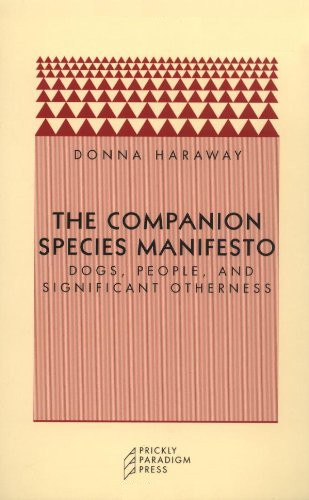Donna J. Haraway: The Companion Species Manifesto: Dogs, People, and Significant Otherness (2003)
Filed under book | Tags: · animal, companion species, dogs, posthumanism

“The Companion Species Manifesto is about the implosion of nature and culture in the joint lives of dogs and people, who are bonded in “significant otherness.” In all their historical complexity, Donna Haraway tells us, dogs matter. They are not just surrogates for theory, she says; they are not here just to think with. Neither are they just an alibi for other themes; dogs are fleshly material-semiotic presences in the body of technoscience. They are here to live with. Partners in the crime of human evolution, they are in the garden from the get-go, wily as Coyote. This pamphlet is Haraway’s answer to her ownCyborg Manifesto, where the slogan for living on the edge of global war has to be not just “cyborgs for earthly survival” but also, in a more doggish idiom, ‘shut up and train.'”
Publisher Prickly Paradigm Press, 2003
ISBN 0971757585, 9780971757585
112 pages
Author’s lecture (video, Sep 2003), (2)
Reviews: Heidi J. Nast (Cultural Geographies, 2005), Rebecca Cassidy (Theory, Culture & Society, 2006), Cristina Pauli Monguilod (Athenea Digital, 2006), Katie Williamsa (Women’s Studies in Communication, 2007).
PDF (updated on 2022-12-22)
Comment (0)Jeffrey Jerome Cohen (ed.): Animal, Vegetable, Mineral: Ethics and Objects (2012)
Filed under book | Tags: · actor-network theory, animal, ecology, ethics, materialism, nature, object, posthumanism, things

Animal, Mineral, Vegetable examines what happens when we cease to assume that only humans exert agency. Through a careful examination of medieval, early modern and contemporary lifeworlds, these essays collectively argue against ecological anthropocentricity. Sheep, wolves, camels, flowers, chairs, magnets, landscapes, refuse and gems are more than mere objects. They act; they withdraw; they make demands; they connect within lively networks that might foster a new humanism, or that might proceed with indifference towards human affairs. Through what ethics do we respond to these activities and forces? To what futures do these creatures and objects invite us, especially when they appear within the texts and cultures of the “distant” past?
Contents: Jeffrey J. Cohen (George Washington University): “Introduction: All Things” – Karl Steel (Brooklyn College): “With the World, or Bound to Face the Sky: The Postures of the Wolf-Child of Hesse” – Sharon Kinoshita (University of California, Santa Cruz): “Animals and the Medieval Culture of Empire” – Peggy McCracken (University of Michigan): “The Floral and the Human” – Kellie Robertson (University of Wisconsin-Madison): “Exemplary Rocks” – Valerie Allen (John Jay College of Criminal Justice): “Mineral Virtue” – Eileen Joy (Southern Illinois University Edwardsville): “You Are Here: A Manifesto” – Julian Yates (University of Delaware): “Sheep Tracks: Multi-Species Impressions” – Julia Reinhard Lupton (University of California, Irvine): “The Renaissance Res Publica of Things” – Jane Bennett (Johns Hopkins University): “Powers of the Hoard: Further Notes on Material Agency”
Response essays: Lowell Duckert, “Speaking Stones, John Muir, and a Slower (Non)humanities” – Nedda Mehdizadeh, “‘Ruinous Monument’: Transporting Objects in Herbert’s Persepolis” – Jonathan Gil Harris, “Animal, Vegetable, Mineral: Twenty Questions”
Publisher Oliphaunt Books, Washington, DC, an imprint of punctum books, May 2012
ISBN 0615625355, 9780615625355
Creative Commons Attribution-NonCommerical-NoDerivs 3.0 Unported License
310 pages
PDF (updated on 2013-10-12)
Comments (3)Peter H. Kahn, Jr: Technological Nature: Adaptation and the Future of Human Life (2011)
Filed under book | Tags: · animal, cognition, engineering, nature, robotics, technology

Our forebears may have had a close connection with the natural world, but increasingly we experience technological nature. Children come of age watching digital nature programs on television. They inhabit virtual lands in digital games. And they play with robotic animals, purchased at big box stores. Until a few years ago, hunters could “telehunt”—shoot and kill animals in Texas from a computer anywhere in the world via a Web interface. Does it matter that much of our experience with nature is mediated and augmented by technology? In Technological Nature, Peter Kahn argues that it does, and shows how it affects our well-being.
Kahn describes his investigations of children’s and adults’ experiences of cutting-edge technological nature.He and his team installed “technological nature windows” (50-inch plasma screens showing high-definition broadcasts of real-time local nature views) in offices on his university campus and assessed the physiological and psychological effects on viewers. He studied children’s and adults’ relationships with the robotic dog AIBO (including possible benefits for children with autism). And he studied online “telegardening” (a pastoral alternative to “telehunting”).
Kahn’s studies show that in terms of human well-being technological nature is better than no nature, but not as good as actual nature. We should develop and use technological nature as a bonus to life, not as its substitute, and reenvision what is beautiful and fulfilling and often essentially wild in our relationship with the natural world.
Publisher MIT Press, 2011
ISBN 0262113228, 9780262113229
230 pages
PDF (updated on 2012-8-1)
Comment (0)
